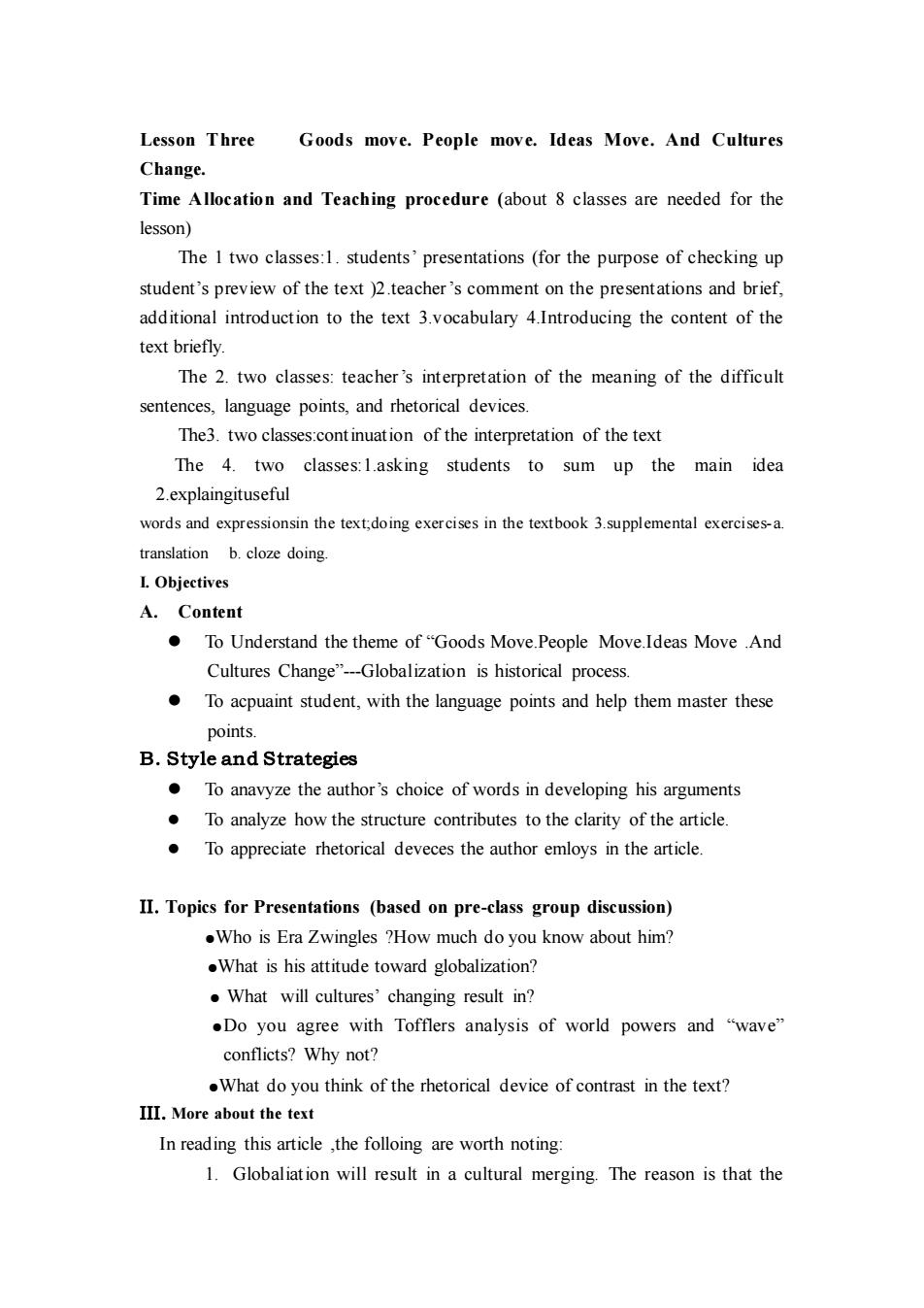正在加载图片...

Lesson Three Goods move.People move.Ideas Move.And Cultures Change. Time Allocation and Teaching procedure (about 8 classes are needed for the lesson) The I two classes:1.students'presentations (for the purpose of checking up student's preview of the text )2.teacher's comment on the presentations and brief, additional introduction to the text 3.vocabulary 4.Introducing the content of the text briefly. The 2.two classes:teacher's interpretation of the meaning of the difficult sentences,language points,and rhetorical devices. The3.two classes:continuation of the interpretation of the text The 4.two classes:1.asking students to sum up the main idea 2.explaingituseful words and expressionsin the textdoing exercises in the textbook 3.supplemental exercises-a. translation b.cloze doing LObjectives A.Content To Understand the theme of"Goods Move.People Move.Ideas Move .And Cultures Change"Globalization is historical process. To acpuaint student,with the language points and help them master these points. B.Style and Strategies To anavyze the author's choice of words in developing his arguments To analyze how the structure contributes to the clarity of the article. To appreciate rhetorical deveces the author emloys in the article. II.Topics for Presentations (based on pre-class group discussion) .Who is Era Zwingles ?How much do you know about him? .What is his attitude toward globalization? .What will cultures'changing result in? .Do you agree with Tofflers analysis of world powers and "wave conflicts?Why not? .What do you think of the rhetorical device of contrast in the text? III.More about the text In reading this article ,the folloing are worth noting: 1.Globaliation will result in a cultural merging The reason is that theLesson Three Goods move. People move. Ideas Move. And Cultures Change. Time Allocation and Teaching procedure (about 8 classes are needed for the lesson) The 1 two classes:1. students’ presentations (for the purpose of checking up student’s preview of the text )2.teacher’s comment on the presentations and brief, additional introduction to the text 3.vocabulary 4.Introducing the content of the text briefly. The 2. two classes: teacher’s interpretation of the meaning of the difficult sentences, language points, and rhetorical devices. The3. two classes:continuation of the interpretation of the text The 4. two classes:1.asking students to sum up the main idea 2.explaingituseful words and expressionsin the text;doing exercises in the textbook 3.supplemental exercises-a. translation b. cloze doing. I. Objectives A. Content ⚫ To Understand the theme of “Goods Move.People Move.Ideas Move .And Cultures Change”-Globalization is historical process. ⚫ To acpuaint student, with the language points and help them master these points. B. Style and Strategies ⚫ To anavyze the author’s choice of words in developing his arguments ⚫ To analyze how the structure contributes to the clarity of the article. ⚫ To appreciate rhetorical deveces the author emloys in the article. II. Topics for Presentations (based on pre-class group discussion) ●Who is Era Zwingles ?How much do you know about him? ●What is his attitude toward globalization? ● What will cultures’ changing result in? ●Do you agree with Tofflers analysis of world powers and “wave” conflicts? Why not? ●What do you think of the rhetorical device of contrast in the text? III. More about the text In reading this article ,the folloing are worth noting: 1. Globaliation will result in a cultural merging. The reason is that the